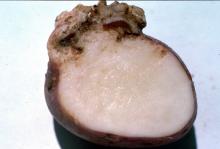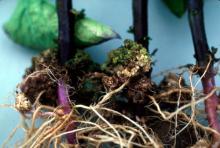Cause Synchytrium endobioticum, a primitive parasitic fungus that does not occur in the United States. Potato wart was found on Prince Edward Island, Canada in 2000, and there was concern that it may have spread to other areas. So far, the disease has not been found in other provinces of Canada or in the United States.
Symptoms The primary symptom is galls on tubers, stolons, and stems and occasionally on leaves but never on roots. These growths start out small and are tan to cream color on portions of the plant below ground; aerial galls or tuber galls exposed to the sun are green. With age, all galls turn brown and then black. Galls may be as small as a pea or the same size or larger than the host tuber.
The galls are formed of both host and fungal tissue. Once galls break down, the resistant survival structures (sporangia) of the fungus are released and may remain viable in the soil up to 30 to 40 years. There is no effective control once the disease is in a field; infested fields must be managed to prevent the organism's spread.
Leave suspect tubers or plants in place and report them to the state Department of Agriculture for confirmation of the disease.



